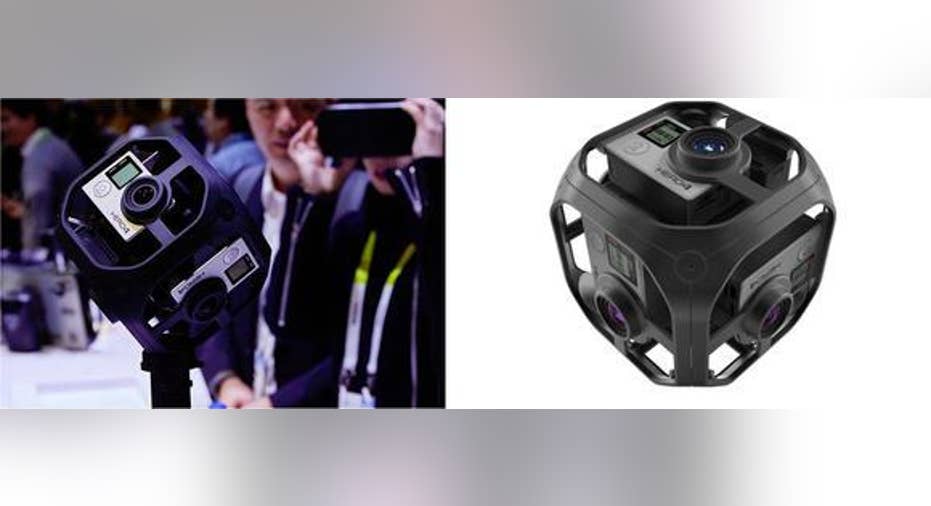GoPro Inc. Launches a Virtual Reality Platform

GoPro recently unveiled GoPro VR, a website and free app for iOS and Android that lets users share and view virtual reality videos. The site promotes the company's new six-camera Omni rig and features a wide variety of music, sports, arts, and entertainment videos.
GoPro VR. Image source: Author's screenshot.
This isn't GoPro's first attempt to spur mainstream interest in 360-degree videos. Last year, it co-designed the 16-camera Odyssey rig with Alphabet's Google. The Odyssey works with YouTube's Jump VR platform to record, stitch together, and share content, but its $15,000 price tag puts it out of the reach of mainstream customers, and it hasn't yet been released. The Omni costs $5,000, which might appeal to aspiring filmmakers, but it remains priced for a niche market.
Stepping away from GoogleThe introduction of GoPro VR suggests that the action camera maker wants to move forward in virtual reality without Google's help. Google launched Jump nearly a yearago, but the Odyssey rig still hasn't beenreleased yet.
Instead, Google made YouTube compatible with a wide variety of cheap 360-degree cameras like the Kodak PixPro SP360, Ricoh's Theta S, IC Real Tech Allie, and 360fly -- which cost between $350 to $600. That move was good for Google, since it made it easier to upload lower-quality spherical videos, but it was bad for GoPro, which thought the Odyssey would help it sell 16 Hero 4 Black cameras at a time.
Google's attempt to broaden the appeal of VR videos with cheaper cameras complements its strategy of letting mainstream consumers experience VR with its cheap Cardboard headset. Google knows that a PixPro video can't match the quality of an Odyssey one, and that the Cardboard can't compete against the Oculus Rift. But for Google, reaching more viewers matters more than producing high-quality content for a handful of early adopters with high-end equipment. That's probably why GoPro stated that it would release a "more casual" spherical camera during YouTube's keynote presentation at CES in January.
GoPro's $5,000 Omni. Image source: GoPro.
Leveraging its brand appealGoPro now has all the parts to create its own VR ecosystem -- a cheaper VR rig, stitching software from Kolor, and its own VR website and app. But the hard part will be convincing a meaningful percentageof its 3.85 million YouTube channel viewers to also view its first-party VR content.
In previous quarters, GoPro seemed to equate brand strength and media growth with the number of followers it had on YouTube, Instagram, and other social networks. However, much of GoPro's social success can also be attributed to the popularity of those sites. According to site tracker Alexa, YouTube is the third-most-visited site in the United States, while GoPro doesn't even crack the top 2,700. But even if GoPro convinces its YouTube viewers to visit GoPro VR, there's no guarantee its customers will be willing to order a $5,000 six-camera rig.
Improving its softwareLaunching a mobile GoPro VR app also complements the company's efforts to beef up its software. In the past, the company was widely criticized for sticking with manual offloading and editing solutions, which seemed archaic compared to automatic cloud-based backup solutions for smartphones like Google Drive.
Last August, GoPro added a "trim and share" feature to its mobile app to enable users to share content without transferring entire video files. This March, it boughtReplay, a mobile app that stitches photos, videos, and music into single videos, and Splice, which offers more advanced video editing features usually found on PCs. The features from those two apps will presumably be added to GoPro's main app in the future. GoPro VR rounds out that suite with the ability to view and share VR content.
Going all-in on VRInvesting in virtual reality seems like the next logical step for GoPro, since demand for its action cameras has slowed dramatically over the past year. Tech M&A advisory firm Digi-Capital claims that the VR market will grow from nearly nothing today to $30 billion by2020.
However, the VR market is still an unproven one, and the high price of VR headsets and cameras could limit its growth until more affordable hardware arrives. If that happens, GoPro will simply have complemented its core action camera business with a niche VR one -- a move which won't prevent its sales from falling off a cliff.
The article GoPro Inc. Launches a Virtual Reality Platform originally appeared on Fool.com.
Suzanne Frey, an executive at Alphabet, is a member of The Motley Fool's board of directors. Leo Sun has no position in any stocks mentioned. The Motley Fool owns shares of and recommends Alphabet (A shares), Alphabet (C shares), and GoPro. Try any of our Foolish newsletter services free for 30 days. We Fools may not all hold the same opinions, but we all believe that considering a diverse range of insights makes us better investors. The Motley Fool has a disclosure policy.
Copyright 1995 - 2016 The Motley Fool, LLC. All rights reserved. The Motley Fool has a disclosure policy.